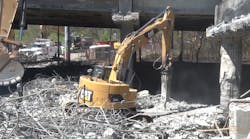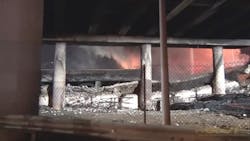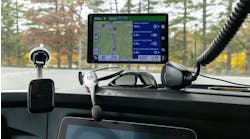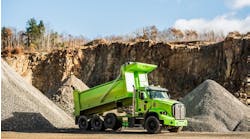If you heard about the collapse last Thursday of a significant overpass section of Atlanta's Interstate 85 — an intense, long-raging fire beneath caused the damage — you saw a stark example of when commercial routing needs are very different than GPS navigation for the passenger car-driving public.
Kelly Frey, vice president of product marketing at fleet management systems provider Telogis, a Verizon company, explains why. To begin with, Atlanta traffic already was notoriously difficult and increasingly saturated, and I-85 before this was handling some 200,000 vehicles every day bound north and south. It runs through downtown Atlanta.
With commuters and other passenger car traffic now facing traffic nightmares for undoubtedly months to come as the overpass is repaired, now consider the additional and specific needs of commercial vehicles when it comes to road issues of various magnitude. This one in particular is very big and will have major implications for freight and commerce along the East Coast.
"If you read all the news and news feeds, they were saying, 'If you're a commercial truck, don't go into downtown Atlanta,'" Frey notes. "That's great, but what about food and groceries? What about commercial goods?
"You can't just avoid it altogether for the next three, four, five, six months until they've got the bridge rebuilt," he continues. So while part of the issue with commercial routing such as Telogis provides, as with passenger cars, is getting around the road disaster, some commercial trucks still actually need to get into and through it.
"We have some big utilities customers, and they may have to rush in in the event of an emergency," Frey tells Fleet Owner. "Or many of our trucking companies may need to rush in with plywood, food, water and so on during these kinds of events."
But beyond any "fix the situation" emergency supplies and response that's needed right away, "the merchants, the manufacturers, water companies, medical companies — everybody who needs goods coming in and out is going to be impacted" for some time, he notes.
Not the same
That's one, but certainly not the only way commercial vehicle operator routing is a different animal than the layman variety of the technology. Cities' roads are built to lighter or heavier tolerances, with the heavy-grade roads providing alternate routes that will support big trucks, so commercial truck routing systems need to account for that and keep truck drivers on the right roads.
Real-time information updates also become especially important when a major issue like the I-85 shutdown is likely to fuel other snarl-ups in Atlanta traffic. Telogis crowdsources data from telematics systems and location information, and other info such as Verizon's de-identified cellular data can also inform the commercial routing system of an event like the I-85 collapse very rapidly.
"You'll hear news reports saying, 'Okay, pull out your navigation — get out your Waze, get your Google Maps," Frey says. "That's really great for a personal vehicle, but if we encourage those truck drivers out there who don't have commercial GPS navigation but want traffic updates, if they pull out those kinds of apps, they're going to route themselves into some pretty sticky situations," he contends.
Other considerations for commercial routing include low bridges trucks could get stuck under, but there are also less-obvious things like an alternate road that eventually dead-ends in a difficult way for a truck. "All of a sudden, that truck driver is having to do a three-point turn on a very small road, or backing up a significant distance in a truck with a 53-ft. trailer. That can be dangerous," Frey notes, and effective commercial navigation needs to be able to identify and route drivers around such problem spots.
Productivity zap
Sure, there's the initial and likely sustained headaches this event will cause just in terms of getting around the Atlanta area, but fleets and trucking companies will need to build in what will be needed to continue doing business.
"The ramifications are serious. All of this is going to cost the merchants in Atlanta more money, because they have to pay those trucking companies, which are going to be avoiding Atlanta," Frey explains. "There's the extra cost of the delay time, because truck drivers will still need to make money.
"If they can't carry as many loads in a day and it's going to be very congested over the next several months, it's going to be harder to get capacity to handle those loads," he adds. "So there are also many implications for productivity."
Longer term
Commercial routing also extends to fleets' route plans going forward, Frey points out. "There's real-time navigation needs, like what's happening right now, where do I turn my truck, what roads do I need to avoid," he notes. "But then there's also longer-term planning called route optimization."
That part of the commercial routing system makes traffic information and exceptions — which, as in the case of the I-85 bridge, will be in place for some time — available in GPS navigation also available to fleet managers and route planners.
"What that means is that when they're building their route plan for the day, week or month, they're going to build an optimal plan based on those road conditions in the future," says Frey. But in examining how commercial navigation and routing must account for and respond to such a large traffic disaster as this, it leads to a final point.
The small roadway issues can be just as important. "We respond to literally hundreds of inbound indications a day, from new construction on a road to literally even something like a low branch hanging over a dock that we put into our on-site navigation. It's also things like snowstorms, fog or hurricanes.
"So this information is important for commercial vehicles for this event, and it's important for things like when the Super Bowl is in town or when the pope visited last year," he continues. "We can have a different route in your navigation in real time to help commercial operators be more productive, efficient and safer regarding these types of events."
::Update Sunday, April 2 on I-85 bridge repair work from the Georgia Dept. of Transportation:




